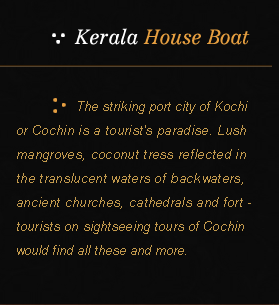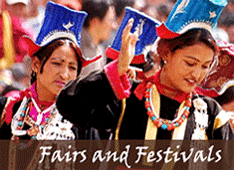Home > Rajasthan Tour Packages > Rajasthan Golden Sand Tour

Duration : 19 Days & 18 Nights
Location : Delhi – Agra – Jaipur – Ranthambhore – Bundi – Chittaurgarh – Udaipur – Narlai – Rohet – Jaisalmer – Gajner – Mandawa – Delhi.
Location : Delhi – Agra – Jaipur – Ranthambhore – Bundi – Chittaurgarh – Udaipur – Narlai – Rohet – Jaisalmer – Gajner – Mandawa – Delhi.
Day 01
Delhi Arrival:
COMPANY REPRESENTATIVE will receive you on arrival at the DELHI AIRPORT and transfer to your hotel.
DELHI, the capital of kingdoms and empires is now a sprawling metropolis with a fascinating blend of the past and the present. It is a perfect introduction to the composite culture of an ancient land. A window to the kaleidoscope - that is India.
Overnight will be at Delhi.
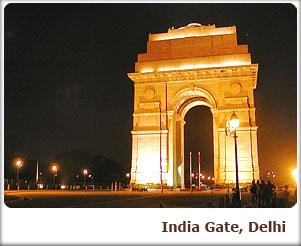 Day 02
Day 02
Delhi:
After breakfast proceed for a day sightseeing tour of the city.
The city is dotted with historic monuments that are the most popular tourist attractions in Delhi. Apart from the monuments, there are museums, markets, gardens and eating joints that you can visit on your tour of Delhi. Some of the important sightseeing places in Delhi are given below.
INDIA GATE: It is the war memorial dedicated to Indian soldiers, who died during World War I. The name of many soldiers who died during World War I is inscribed on its wall. Edward Lutyens, the man who planned and built New Delhi, designed India Gate. Almost every foreign tourist visits the monument. 'Amar Jawan Jyoti', the eternal flame is added later. The eternal flame runs on gas and is a tribute to soldiers who lost their lives in the service of the nation.
RED FORT: Located in Old Delhi, the Red Fort or Lal Quila is a popular tourist attraction in Delhi. The fort was built by the Mughal emperor Shah Jahan in 1648, when he moved his capital from Agra to Delhi. The construction of the Fort started in 1638 and it was completed 10 years later in 1648. Some of the important spots inside the Red Fort include royal baths or Shahi hamams, Shahi Burj, Moti Masjid or the Pearl Mosque, Diwan-e-Aam and Diwan-e-Khas.
JAMA MASJID: The largest mosque in India, the Jama Masjid was built by Shah Jahan 1656 AD. About 5,000 laborers and craftsmen worked for six years to complete the monument. The mosque can accommodate about 25,000 people. The mosque is located in the old Delhi. The domes are built in white marble. The prayer hall of the mosque has 260 pillars.
OLD FORT: Old Fort or Purana Quila as it is called is located near Pragati Maidan on the Mathura Road. You can club a visit to the Old Fort with your tour of Red Fort and Jama Masjid as the three monuments are located in Old Delhi and are not too far from one another. Humanyun’s started the construction of the fort in 1533 AD, but before the completion of the fort, Sher Shah Suri defeated him and captured Delhi. Sher Shah Suri completed the fort and named it -Shergah. He added many structures to the fort, of which Qila-I-Kuhna Mosque and Sher Mandal are worth mentioning. In 1555, Humanyun’s re-captured Delhi and converted Sher Mandal into a library.
HUMANYUN’S TOMB: Humanyun’s Tomb is mausoleum of the Mughal emperor Humanyun’s. Bega Begum also known as Haji Begum, wife of Humanyun’s constructed the mausoleum for her husband. The tomb was built between 1562 and 1572 AD. The tomb was designed by Mirak Mirza Ghiyuth.
QUTAB MINAR: The construction of the Qutab Minar was stated by Qutub-ud-din Aibak in 1199 AD but he died before completing it. His son-in-law and successor Iltutmish completed the construction of the building. Qutab Minar is located in Meharauli.
LOTUS TEMPLE: Also known as the Bahai Temple, the monument was opened to public only in 1986. Located near Nehru Place, the Lotus Temple is designed like a lotus flower. If you are looking for some moments of peace and tranquility in the crowded city, Lotus Temple is the ideal place to visit.
Apart from the above-mentioned sightseeing options, there are various other tourist attractions that you can visit on your tour of Delhi. Some other sightseeing places in Delhi include Lodi Gardens, National Museum, Jantar Mantar, Dilli Haat and the Garden of Five Senses.
Overnight will be at Delhi.
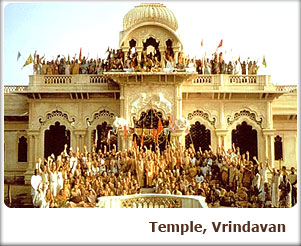 Day 03
Day 03
Delhi – Mathura – Vrindavan - Agra:
BY Road 202Kms/05hrs
Breakfast will be at the hotel.
Drive to Agra visiting Mathura & Vrindavan enroute.
The divine land, the home of Lord Krishna that still pounding with the spiritual memoir of the Lord's vast charisma; It is believed that this is the place where about 5,000 years ago Lord Krishna was born in the prison of King Kansa.
Mathura an ancient holy city in India derives its eminence from being the birthplace of Lord Krishna. Situated at a distance of 145 kms from Delhi and 58 kms from Agra in the state of Utter Pradesh, the city is known for its many temples dedicated to the Lord Krishna located at Katra, Keshav Deo, the temples are visited by pilgrims from all over the world. The Temple Dwarkadish built by Seth Gokul Das of Gwalior in 1814 is arrayed with some ethereal pictures depicting the entire life of Krishna.
In 600 BC Mathura was the capital of Braj situated on the West Bank of river Yamuna. Today Mathura has become the sacred place of religious and epic interest and attracts pilgrims from the Hindu, Buddhist and Jaina religion. All round the year, a large number of festivals and fairs are held in Mathura and the bordering areas of Vrindavan, Gokul, Barsana and Goverdhan.
Reach Agra and check into the hotel.
AGRA: Two great Mughal monarchs, Akbar and Shah Jahan, transformed the little village of Agra into a befitting second capital of the Mughal Empire – giving it the name Dar-ul-Khilafat {seat of the Emperor}. Today a visitor to Agra is caught up in a world of contrasting edifices, of red sandstone and white marble, narrow galleys and quaint buggies, and that irresistible charm that this favorite city of the Mughals still retains. It is not surprising, that modern Agra still reflects its Mughal heritage most conspicuously. A walk down the narrow bustling streets of the city will introduce the visitor to the wafting aroma of Mughlai cuisine.
Overnight will be at Agra.
Day 04
Agra:
Enjoy breakfast at the hotel.
Proceed for day sightseeing of Agra.
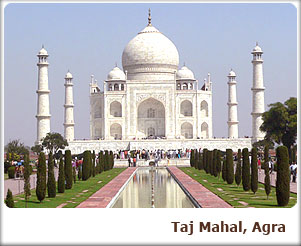 THE TAJ MAHAL – AN EMPEROR’S LAMENT: Agra is the city of the Taj Mahal. It is a sublime experience of the greatest love story ever told. Today India's most fascinating and beautiful masterpiece, this perfectly symmetrical edifice is set amidst landscaped gardens on the banks of the Yamuna River. The Taj was built by the Mughal Emperor Shahjahan as a memorial to his wife, Mumtaz Mahal. After her untimely death, Shah Jahan had her mortal remains buried in this mausoleum. And after his own demise he was placed to rest next to his beloved queen in the same mausoleum. Under the dome, below the ground level, in a dimly lit chamber, lie the mortal remains of Shahjahan and his beloved queen Mumtaz, reminding the world of their undying love. The Taj remains closed for visitors on Friday
THE TAJ MAHAL – AN EMPEROR’S LAMENT: Agra is the city of the Taj Mahal. It is a sublime experience of the greatest love story ever told. Today India's most fascinating and beautiful masterpiece, this perfectly symmetrical edifice is set amidst landscaped gardens on the banks of the Yamuna River. The Taj was built by the Mughal Emperor Shahjahan as a memorial to his wife, Mumtaz Mahal. After her untimely death, Shah Jahan had her mortal remains buried in this mausoleum. And after his own demise he was placed to rest next to his beloved queen in the same mausoleum. Under the dome, below the ground level, in a dimly lit chamber, lie the mortal remains of Shahjahan and his beloved queen Mumtaz, reminding the world of their undying love. The Taj remains closed for visitors on Friday
SIKANDRA: Sikandra, 10 Kms North West of Agra, is the final resting place of Emperor Akbar. The Tomb of Akbar shows an interesting fusion of Hindu and Mughal architecture reflecting the spirit of the Mughal Emperor Akbar. Akbar began the construction of his own garden mausoleum during his lifetime, a red sandstone structure in a char-Bagh meaning 4-square formal garden.
AGRA FORT – ARCHITECTURAL WONDER IN STONE: Within a radius of 3 kilometers, on the banks of the river Yamuna raises the crescent like Agra Fort. Designed and built by Akbar in 1565 A.D., the fort is surrounded by a 70 feet high wall. It houses the beautiful Pearl Mosque and numerous palaces including the Jahangir Mahal, Diwan-i-Khas, Diwan-i-Am and Moti Masjid. Later it was used by his son Jahangir also as the seat of power. Shahjahan modeled his creation, the Red Fort at Delhi on this fort. The Agra fort happens to be on the same bank of the river Yamuna as the Taj Mahal which is visible in all its beauty from one side of the fort. So very ironically, Shahjahan, a prisoner of his son Aurangzeb in his old age was put in a cell from where he could gaze at the Taj Mahal at a distance, from his cell in the Agra Fort.
The fort has four gates and is enclosed by a double barricaded wall of red sand stone. Many buildings were constructed within the fort of which very few remain till date. One of the most significant ones is the multi storied Jahangir Mahal built by Akbar for his wife Jodha Bai.
The Mahal is reached through an impressive gateway and its inner courtyard consists of beautiful halls, profuse carvings on stone, exquisitely carved heavy brackets, piers and cross beams.
ITMAD – UL – DAULAH’A TOMB: This tomb was erected by Nur Jahan in sweet memory of her father Ghiasud-Din-Beg between 1622 - 1628 A.D. This white marble structure of the pre-Taj era though smaller is often considered equal if not better to the great one itself.
Overnight will be at Agra.
Day 05
Agra – Fatehpur Sikri – Jaipur:
BY Road 232Kms/05hrs
Breakfast will be at hotel.
Drive to Jaipur visiting Fatehpur Sikri enroute.
FATEHPUR SIKRI – THE CITY OF VICTORY: 37 Kms from the city of Agra, stands Fatehpur Sikri, Akbar’s capital. Full credit goes to the Archeological Survey of India for this perfectly preserved example of a Mughal city at the height of the empire’s splendor. It is an attraction no visitor to Agra should miss. This sprawling structure is made of red sandstone and combines both Hindu and Mughal architecture. This walled city contains the mausoleum of the Sufi fakir, Saleem Chisti who is said to have granted Akbar and his Hindu queen Jodhabai their wish for a son. The main entrance to Fatehpur Sikri is through the 175 feet Buland Darwaza, the highest gateway in the world. It was built by Akbar to commemorate his victory over Khandesh in Gujarat.
The Panch Mahal is a five-storeyed tower, the highest point in Fatehpur Sikri. This extremely airy tower is supposed to have been used by one of the emperor's many queens.
After lunch continue drive to beautiful Pink City – Jaipur. Reach and check in at hotel.
Jaipur is the capital of the state of Rajasthan a romantic realm of resplendent palaces, mighty fortresses and regal Maharajahs that lies in the western deserts and is an utterly unique part of India. Proudly belonging to the KSHATRIYA warrior caste and fiercely independent, the Rajput princes made fearsome foes. However, many of them realized that to maintain their wealth and authority locally, it was expedient to proclaim allegiance to the central power. Thus, many enjoyed a privileged position under the Mughal emperors and also the British Raj that followed.
The bustling Rajasthan capital of Jaipur takes its name from its venerated founder Jai Singh II, who was given the title Sawai Maharaja by the Mughal. Literally translated this would mean ’one and a quarter’, suggesting that the Mughal thought this emperor to be more valuable than just ‘one’. Jaipur is known as the ’Pink City’ on account of the distinctive colour of its buildings. This did not, however, form part of the original plan, but dates back to 1856, when the city was given a wash of pink in honor of a State Visit from Prince Albert.
This evening, visit the Birla Temple to learn more about the fascinating religious life of Jaipur. The marble structure, built as recently as 1985, houses ornate statues including one of Lakshmi (goddess of Wealth and Beauty) and Narayan dressed in gaudy robes, representing a Hindu vision of heavenly luxury. Carvings in the temple and on pillars supporting the covered walkways include images of the Hindu pantheon, as well as Jesus, the Blessed Virgin Mary and St Francis of Assisi. Your visit will coincide with the AARTI Ceremony, which involves oil lamps being lit and waved, in order to awake and invoke the deity.
Enjoy the experience and spend night at Jaipur.
Day 06
Jaipur:
After breakfast drive to Amber Palace. Enjoy Elephant Back ascent to the Fort.
AMER PALACE & FORT: Amer Fort and Palace was originally built by Raja Man Singh and subsequently developed by Sawai Jai Singh. The major attractions are Sheela Devi Temple, Sheesh Mahal (Hall of mirrors), Jai Garh Fort a few kilometers from the city centre was built for the defence of the town and has one of the world’s biggest cannons on wheels and a rich collection of arms and weapons.
Continue city sightseeing.
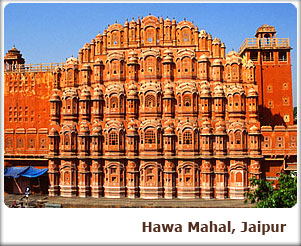 HAWA MAHAL (PALACE OF WINDS): Hawa Mahal is the most strikingly designed monument in Jaipur. Built by the Poet-King Sawai Pratap Singh in 1799, the Hawa Mahal is centrally located and is multiniched five storey high back view of the compled. It was conceived to provide an adequate vantage position behind delicate stone-carved jali, screens for the palace women to watch the royal processions passing through the Bazar below without being seen by outsiders. The Top of the palace affords a beautiful view of the city. A small archaeological museum is yet another attraction in the palace.
HAWA MAHAL (PALACE OF WINDS): Hawa Mahal is the most strikingly designed monument in Jaipur. Built by the Poet-King Sawai Pratap Singh in 1799, the Hawa Mahal is centrally located and is multiniched five storey high back view of the compled. It was conceived to provide an adequate vantage position behind delicate stone-carved jali, screens for the palace women to watch the royal processions passing through the Bazar below without being seen by outsiders. The Top of the palace affords a beautiful view of the city. A small archaeological museum is yet another attraction in the palace.
JAL MAHAL: The Jal Mahal Palace, Jaipur is noted for its intricate architecture. The Palace was developed as a pleasure spot. It was used for the royal duck shooting parties. On the road to Amber at a distance of 6.5 Kms from Jaipur are the cenotaphs of the royal family. A causeway leads to Jal Mahal Palace situated in the middle of Man Sagar Lake, opposite the cenotaphs. The first four floors of this building is under water, only the top floor remains outside. One can have a wonderful view of the lake and the palace from Nahar Garh Fort Built in 1799, the palace is now abandoned, but reasonably well preserved. In the monsoons, it looks particularly startling with its red sandstone set against the water hyacinth filled lake.
THE CITY PALACE: The city Palace is a historic landmark. The Carved arches are supported by grey-white marble columns studded with floral motifs in gold and colored stones. Two elephants carved in marble, guard the entrance, where retainers whose families have served generations of the rulers are at hand, to serve as guides.
JANTAR MANTAR Jantar Mantar is one of Sawai Jai Singh’s five remarkable observatories. Constructed with stone and marble its compled instruments, whose setting and shapes are precisely and scientifically designed, represent the high-points of medieval Indian Astronomy. The two Ram Yantras used for gauging altitudes are unique in their isolation. This is the largest of five observatories founded by Sawai Jai Singh-II in various parts of the country.
This evening is free for you to relax shop or explore independently. Shopping is superb in Jaipur, particularly for gold and silver jewellery, pottery, tie-dye materials, silk, saris, wooden handicrafts and carpets.
Overnight will be at Jaipur.
Day 07
Jaipur – Ranthambhore:
By Road 170Kms/05hrs
Breakfast will be at the hotel.
Drive to Ranthambhore. Reach and check into the hotel.
Ranthambore National Park is in Sawai Madhopur District of Rajasthan state. Located at the junction of the Aravalli and Vindhya hill range, this is one of the finest places to view animals, especially as they are used to being stared at here. The park covers an area of Approximately 400 sq Km and if combined it with the area of sawai man Singh sanctuary area, it is around 500 Sq km.
Ranthambore national park was declared a wildlife sanctuary in 1957 and in 1974 it gained the protection of "Project Tiger". It got its status of a National Park in 1981. Ranthambore National Park is dotted with structures that remind you of bygone eras. There are many water bodies located all over the park, which provide perfect relief during the extremely hot summer months for the forest inhabitants. A huge fort, after which the park is named, towers over the park atop a hill. There are many ruins of bygone eras scattered all over the jungle, which give it a unique, wonderful and mixed flavor of nature, history and wildlife. Tigers at Ranthambore National park have been known to even hunt in full view of human visitors. These tigers are famous for being seen in the daytime too, due to their lack of fear of human presence in vehicles. This lack of fear of humans is excellent for tourists, as they get to see the tigers often.
This National park is a wildlife enthusiast and photographer's dream. It offers excellent accommodation and internal transportation facilities. The park remains open every year from October to May. Famous for the exciting and frequent tiger sightings captured dramatically in several books, this park is today affected by ecological pressures and poaching.
In Nutshell, Ranthambore National park is a wildlife enthusiast and photographer's dream.
Timings for entry into, and exit from, the park vary according to the season. In winters, due to the shorter duration of daylight hours, the morning entry time is later and evening exit time is earlier.
Overnight will be at Ranthambore.
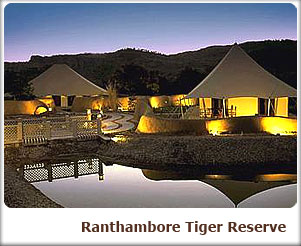 Day 08
Day 08
Ranthambhore:
Wake up early morning and leave for your safari into the National Park. Track the tigers and other wildlife through the morning. Return to the resort / lodge by 1000 in the morning and have breakfast.
Freshen up and either spends time at the pool or visit the town. You could also go for a nice visit to the temple on top of the fort.
In the afternoon have lunch and then leave again for you afternoon safari. The safari will be till evening 1700 – 1800 hr and then return to the resort / lodge.
Dinner will be at the resort and retire early for the night.
Overnight will be at Ranthambhore.
Day 09
Ranthambhore – Bundi:
By Road 130Kms/03hrs
Breakfast will be at the hotel.
Drive to Bundi. Reach and check into the hotel.
The Bundi district of Rajasthan attracts tourist from all over the world. The destination provides tourist spots for both the foreign and domestic visitors. The place offers a unique culture with baoris, palaces & forts, lakes and the beautiful natural surroundings. Bundi is known for attractive step wells and tanks. These are about 50 in number and mark the town's streets and bylanes. Interesting monuments including impressive medieval forts, palaces, 'havelis', temples and 'chhatris' with elegantly carved pillars, along with a picturesque lake in the heart of the town, add to its appeal.
Relax and then proceed for the sightseeing.
Taragarh or the Star Fort: The fort was built in 1354 A.D., and is one of the most impressive forts of Rajasthan. Located on a thickly wooded hill is a marvelous white fort with a huge reservoir, which once supplied water to the palace.
The Palace: This magnificent edifice showcases the Rajput architecture. The palace houses some of the superb Bundi murals.
Chhattar Mahal or Palace or Towers: A steep, paved carafe-way is the only way to reach the monument. Of special interest in the palace is the Hazari Pol or Gate of the thousand, the Naubat Khana, the Hathi Pol with its old water clock and the Diwann-e- Aam.
Ratan Daulat: It is a very interesting structure built by Rao Raja Ratan Singh, forming a stable for nine horses and a Hatia Pol. Prior permission required to visit this place.
Chitrashala: This is an interesting pavilion and a gallery of miniature murals adorns the palace. Elaborate colorful paintings on the walls depict scenes from the 'Ragmala' and 'Raaslila'-the Radha-Krishna story.
Nawal Sagar: Visible from the fort is the square artificial lake of Nawal Sagar, broken up by islets. A temple dedicated to Varuna, the Aryan god of water, stands half submerged in the center of the lake. The reflection of the entire city and its palaces can be seen in the lake -making it a unique attraction of Bundi.
Overnight will be at Bundi.
Day 10
Bundi – Chittaurgarh:
By Road 180Kms/05hrs
Breakfast will be at the hotel.
Drive to Chittaurgarh. Reach and check into the hotel.
Chittaurgarh showcases the royalty and glory of Rajasthan in the form of its various magnificent forts and monuments. It is a ruined citadel where the royal past lives in the imposing forts, graceful palaces and spectacular chhatris. The entire city echoes with the tales of love and gallantry unique to the Rajput tradition. This fortified settlement has been ravaged thrice and each time the outcome was ‘Jauhar’-when women and children immolated themselves on a huge funeral pyre while men donned in saffron robes of martyrdom rode out of the fort towards a certain death.
Relax and then proceed for the sightseeing.
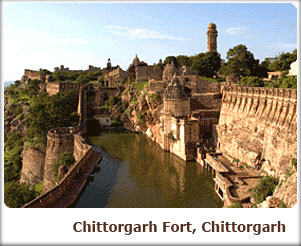 The Fort: The indomitable pride of Chittaur, the fort is a massive structure with many gateways built by the later Maurya rulers in 7th century A.D. Perched on a height of 180 m. high hill, it sprawls over 700 acres. The tablets and chattris within are impressive reminders of the Rajput heroism. The main gates are Padal Pol, Bhairon Pol Hanuman pol and Ram Pol. The fort has many magnificent monuments-all fine examples of the Rajput architecture. The ancient ruins of the fort are worth spending few moments in solitude.
The Fort: The indomitable pride of Chittaur, the fort is a massive structure with many gateways built by the later Maurya rulers in 7th century A.D. Perched on a height of 180 m. high hill, it sprawls over 700 acres. The tablets and chattris within are impressive reminders of the Rajput heroism. The main gates are Padal Pol, Bhairon Pol Hanuman pol and Ram Pol. The fort has many magnificent monuments-all fine examples of the Rajput architecture. The ancient ruins of the fort are worth spending few moments in solitude.
Vijay Stambh (Victory Tower): The imposing 37 meter high structure with nine storeys, covered with exquisite sculptures of Hindu deities and depicting episodes from the two great epics - Ramayana and Mahabharata. It was built in 1440 A.D. by Maharana Kumbha, a powerful ruler of Mewar, to commemorate his victory over the Muslim rulers of Malwa and Gujarat.
Kirti Stambh (Tower of Fame): The 22 meter high tower by a wealthy JAIN merchant in the 12th century A.D. The tower is dedicated to Adinathji, The first of the Jain Tirthankaras and is decorated with figures of the Jain pantheon.
Rana Kumbha’s Palace: The ruined edifice of great historical and architectural interest, being the most massive monument in the fort of Chittaur. The palace is believed to have underground cellars where Ranio Padmini and other women committed Jauhar.
Padmini’s Palace: Built beside a pool, the palace is a magnificent one. It was here that Rana Ratan Singh showed a glimpse of queen Padmini to Alauddin Khilji. Rani Padmini stood in a ‘Zanana Mahal’- a pavilion in the centre and her reflection was visible to Alauddin Khilji in a mirror placed in the main hall. After having a glimpse of the legendary beauty, Alauddin went to extend to ravaging Chittaur in order to possess her.
Government Museum: The magnificent Fateh Prakash Mahal, presently a fine Museum with an exquisite example of sculptures from temples and buildings in the fort is worth a visit.
Jaimal and Patta Palaces: The ruins of palaces of Rathore Jaimal and Sisodia Patta are witness to the gallantry of these great warriors.
Overnight will be at Bijaipur.
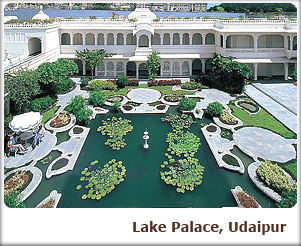 Day 11
Day 11
Bijaipur – Udaipur:
By Road 180Kms/05 hrs
Breakfast will be at the hotel.
Drive to Udaipur. Reach and check into the hotel.
The city of Dawn, Udaipur is a lovely land around the azure lake, hemmed in by the lush hills of the ARAVALLIS. A vision in white drenched in romance and beauty, Udaipur is a fascinating blend of sights, sound and experiences and inspiration for the imagination of poets, painters and writers.
Its kaleidoscope of fairy-tale palaces, lakes, temples, gardens and narrow lanes strewn with stalls, carry the flavor of a heroic past, epitomizing valor and chivalry. Their reflection in the placid waters of the LAKE PICHOLA is an enticing sight. Udaipur is the jewel of MEWAR -a kingdom ruled by the Sisodia dynasty for 1200 Years.
Overnight will be at Udaipur.
Day 12
Udaipur:
Breakfast will be at hotel.
Proceed for sightseeing tour of Udaipur, stopping first at City Palace.
CITY PALACE: Udaipur’s fascinating City Palace is the largest royal complex in Rajasthan. Standing on a rocky promontory the palace has balconies, towers and cupolas and presents a wonderful view of the lake and the city. The complex has eleven constituent Mahals (palaces), constructed by successive maharanas during the three hundred years that followed the foundation of Udaipur in 1559. Added to this, Crystal Gallery and Durbar Hall within the complex is spectacular. Explore them for their mosaics, miniatures, mirror work and motifs.
Here you will marvel at rooms with mirrored walls and ivory doors, colored glass windows and inlaid marble balconies and the Peacock Courtyard.
SAHELION KI BARI: The "garden of the maids of honour", Sahelion-ki-Bari was designed and laid out early in the eighteenth century as a retreat for ladies of the royal household to spend their time in leisure. The lotus pool, fountains, lawns, flowerbeds, and marble pavilions all combine to make it a captivating place.
BAGORE KI HAVELI: Situated on the picturesque bank of Pichola Lake, This Haveli was built by Shri Amarchand Badwa, who was the Prime Minister of Mewar-the rulers of Mewar Pratap Singh, Maharana Ari Singh, and Maharana Hamir Singh during the period 1751 to 1778. This palatial building reportedly has 138 rooms, balconies, terraces, courtyards and corridors. The glass and mirror inlay within the Haveli is Unique and procured in its original form. The two peacocks made with small pieces of colored glasses are unique reflection of the finest craftsmanship of glass work. What was once upon a time a living centre of nobility of Udaipur lay in darkness and ruin for nearly half a century till when it was handed over to the West Zone Cultural Centre (WZCC) in 1986.
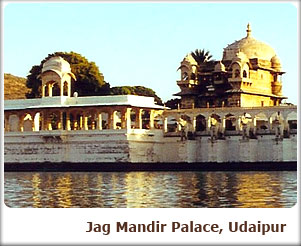 JAGDISH TEMPLE: Built in 1651 A.D. by Maharana Jagat Singh, this Indo-Aryan temple is dedicated to Lord Jagannath, a manifestation of Vishnu. The largest and the most beautiful temple of Udaipur, it is always seething with constant activity and noted for its beautiful sculpted images and towering Shikhara.
JAGDISH TEMPLE: Built in 1651 A.D. by Maharana Jagat Singh, this Indo-Aryan temple is dedicated to Lord Jagannath, a manifestation of Vishnu. The largest and the most beautiful temple of Udaipur, it is always seething with constant activity and noted for its beautiful sculpted images and towering Shikhara.
FATEH SAGAR: West of Sahelion-ki-Bari is Fateh Sagar, a lake built by Maharana Fateh Singh. It is bordered by sharp hills and a canal built at the beginning of the twentieth century connects it to the Lake Pichola. In the middle of the lake is Nehru Park, a popular garden island with a boat-shaped cafe.
BHARATIYA LOK KALA MANDIR: Bharatiya Lok Kala Mandir is home to an attractive collection of folk dresses, puppets, ornaments, dolls, masks, folk musical instruments, folk deities and paintings. The museum is the best place for those interested in puppetry. Short amusing puppet shows are staged throughout the day. In addition, the museum runs short courses in puppet making and theatre.
Proceed for Evening Motor launch cruise on the placid waters of Lake Pichola. From the boat you will be able to view the city of Udaipur as it rises majestically above the lake in the middle of the Rajasthan desert. Also visit the Jag Mandir Palace - the other island palace in the middle of the lake. Spend some time at the Jag Mandir Palace.
JAG MANDIR: Jag Mandir, another island palace in the Lake Pichola was built by Karan Singh in 1615. It derives its name from Jagat Singh who added to the initial structure. It was never used for the purpose for it was built. This palace was used to provide shelter to the Mughal prince Khurum (later Emperor Shah Jahan) who rebelled against his emperor father Jahangir, in the 1620s. Jahangir was succeeded by Shah Jahan who was still in Udaipur at the time of his father's death. During the 1857 Mutiny this island palace once again served as a safe haven for European women and children.
Overnight will be at Udaipur.
Day 13
Udaipur – Narlai:
By Road 140kms/02hrs
Breakfast will be at the hotel.
Proceed to Narlai. Reach and check into the hotel.
Situated in Narlai Village in Pali is the Rawla Narlai. The Rawla Narlai, Pali belongs to the royal family of Jodhpur. One of the ancient 17th century forts it was renovated by Maharaja Swaroop Singhji into a famous heritage hotel in Pali. The refurbished Rawla Narlai in Pali recreates the medieval magic of yesteryears which allures tourists from all over.
Enjoy evening in Narlai.
Overnight will be at the hotel.
Day 14
Narlai – Rohet:
By Road 80kms/01hrs
Breakfast will be at the hotel.
Proceed to Rohet. Reach and check into the hotel.
ROHET is the fortified desert home of the descendants of the 16th century Rathore of the Champawat clan, Thakur Dalpat Singh I. The "Jagir" (Fiefdom) of Rohet was bestowed upon him in 1622 A.D. by the Maharaja of Jodhpur, as a mark of appreciation for his bravery in battle. Generations of valiant noble-men have built this heritage home where, notwithstanding the inroads of modernity, aristocratic values are respected. The visitor of today experiences the famed warmth of courteous Rajput hospitality.
Brilliantly plumed peacocks strut about, perching themselves under finely carved stone archways and the wind whispers through the neem tree groves and bougainvilleas.
Rohet Garh is a recognized Heritage Hotel. Rare among hotels it has remained a family home, where the members of the erstwhile ruling family welcome you personally as their honored guest. Its elegantly appointed rooms have their own individual character and furnishings. Rooms are air-conditioned and have attached bathrooms and modern facilities. The drawing room has ornately carved wooden ceiling, traditional lamps and old photographs. You are invited to relax in spacious verandah lounges decorated with historic trophies and artifacts.
There is a beautifully designed swimming pool with four charming pavilions at each corner where musicians perform in the evenings as dinner is served by the poolside. Often, folk dancers enliven the evenings with their vibrant hues and vigorous rhythms.
Overnight will be at the hotel.
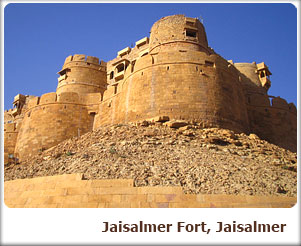 Day 15
Day 15
Rohet – Jaisalmer:
By Road 235kms/6.5hrs
Breakfast will be at the hotel.
Drive to Jaisalmer. Reach and check into the hotel.
Rising from the heart of the Thar Desert like a golden mirage is the city of Jaisalmer. A commanding fort etched in yellow sandstone stands, with its awesome splendor, dominating the amber-hued city.
The city has an interesting legend associated with it, according to which, Lord Krishna-the head of the Yadav Clan, foretold Arjuna that a remote descendent of the Yadav Clan would build his kingdom atop the Trikuta Hill. His prophecy was fulfilled in 1156 AD when Rawal Jaisal, a descendent of the Yadav Clan and a Bhatti Rajput, abandoned his fort at Lodurva and founded a new capital -Jaisalmer, perched on the Trikuta Hill.
Overnight will be at Jaisalmer.
Day 16
Jaisalmer:
After breakfast proceed for the sightseeing.
JAISALMER FORT: The 12th century Jaisalmer Fort is one of the most formidable forts in Rajasthan, India. Perched on Trikuta hill, Jaisalmer Fort is a 250 ft tall and massive fort surrounded by a 30 ft high sandstone wall with 99 bastions, offering a spectacular sight to visitors. The Fort also houses a Jain Temple.
JAISALMER HAVELIS: Once the residence of wealthy merchants, the havelis (mansions) of Jaisalmer are famous for their artistic designs and decorations. Their exclusive cutwork, yellow and red stone treatment, and the bracket-shaped decoration of peacocks, never fail to mesmerize the visitors. The Patwon-Ki-Haveli, Salim-Singh-Ki-Haveli and Nathmal ji-Ki-Haveli are major tourist attractions in Jaisalmer.
NATHMAL KI HAVELI: Two architect brothers built it in the 19th century. Interestingly, while one concentrated on the right, the other concentrated on the left and the result is a symphony epitomizing the side by side symmetry during construction. Paintings in miniature style monopolize the walls in the interior. Mighty tuskers carved out of yellow sandstone stand guard to the Haveli.
SALIM SINGH KI HAVELI: This Haveli was built about 300 years ago and a part of it is still occupied. Salim Singh was the prime minister when Jaisalmer was the capital of the princely state and his mansion has a beautifully arched roof with superb carved brackets in the form of Peacocks. The mansion is just below the hill and it is said that once it had two additional wooden storeys in an attempt to make it as high as the maharaja's palace, but the maharaja had the upper storey torn down.
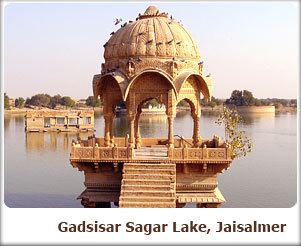 PATWON JI KI HAVELI: This is one of the largest and most elaborate Haveli in Jaisalmer and stands in a narrow lane. It is five storeys high and is extensively carved. It is divided into six apartments, two owned by archaeological Survey of India, two by families who operate craft-shops and two private homes. There are remnants of paintings on some of the inside walls as well as some mirror work.
PATWON JI KI HAVELI: This is one of the largest and most elaborate Haveli in Jaisalmer and stands in a narrow lane. It is five storeys high and is extensively carved. It is divided into six apartments, two owned by archaeological Survey of India, two by families who operate craft-shops and two private homes. There are remnants of paintings on some of the inside walls as well as some mirror work.
GADSISAR SAGAR LAKE: A famous picnic spot in the sandy city, Gadsisar Sagar Lake is among the most beautiful tourist attractions in Jaisalmer. It attracts hundreds of migratory birds during the winter season. Bara Bagh: Located on the bank of Gadsisar Sagar Lake, Bara Bagh is an oasis in the desert. The lush green garden provides much-needed relief to the local people.
TAZIA TOWER: The pagoda like Tazia Tower rises from the Badal Mahal (Palace of Clouds). The beautiful five-tiered tower is known for its beautifully carved balconies on each storey.
JAIN TEMPLES: These fine Jain temples were built in the 12th to 15th century, within the Jaisalmer Fort. They are beautifully carved and dedicated to Rikhabdevji and Sambhavnathji. The Gyan Bhandar, a library containing some extremely old manuscripts, is within the temple complex.
In the late afternoon, proceed to the SAND DUNES for visiting the typical Rajasthani Desert Village. View the sunset from the dunes, as the sky is set on fire. Return to the village for dinner amidst Rajasthani musicians playing haunting tunes.
Overnight will be at Jaisalmer.
Day 17
Jaisalmer – Gajner:
By Road 330Kms/06hrs
After breakfast proceed to Gajner. Reach and check into the hotel.
Gajner Palace is a Grand Heritage Palace of the HRH Group of Hotels. Spread over 6000 acres, the palace is a 30-minute drive from Bikaner. Gajner Palace was built on the banks of Gajner Lake by Sir Ganga Singhji, one of the greatest Maharajas of Bikaner, in the early decades of the twentieth century.
Gajner Palace was used as a hunting resort by the former Maharajas and visiting British dignitaries during the days of the Raj. During the reign of Maharaja Ganga Singh, this palace was used for grand shoots and lavish entertainment. Christmas season was often celebrated with prearranged duck and Imperial Sand Grouse shoots. Royalty, Viceroys and other dignitaries were usually invited on these grand occasions.
The red sandstone palace is distinguished for its architectural grandeur and luxuriously appointed suites and rooms. The greenery at Gajner Palace, lawns and the chirping of birds and peacocks make it a truly memorable destination for leisure and corporate travellers.
Relax and then proceed for the sightseeing.
Overnight will be at Gajner.
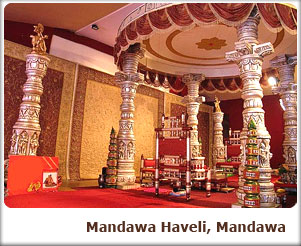 Day 18
Day 18
Gajner – Bikaner - Mandawa:
By Road 140Kms/04hrs
After breakfast proceed to Mandawa visiting Bikaner enroute.
Bikaner is a beautiful city in the northwestern part of Rajasthan and is a major tourist attraction of the state. Junagarh Fort, camel breeding farm and camel festival are the major tourist attractions of Bikaner. Besides, there are various other tourist attractions of Bikaner like Lalgarh Palace, Deshnoke temple, Karni Mata etc. that you must visit on your Bikaner Travel. The Rajputana Getaway offers to give you online information on other tourist attractions in Bikaner in Rajasthan, India.
Reach Mandawa and check into the hotel.
Mandawa is one of the beautiful historical towns which attract tourists from all over. A few kilometers from Jaipur, Mandawa is one of the sleepy hamlets of Rajasthan that recalls the glory and grandeur of yesteryears.
From grand Forts, Havelis and palatial mansions, Mandawa is truly one of the ideal destinations for the history lovers. From paved archways to mirror works, paintings and murals and exquisitely designed architectural marvels, Mandawa is considered to be an open air art gallery.
The Tourist Attractions in Mandawa are all about these beautiful forts and Havelis. One of the important tourist attractions of Mandawa is the beautiful Mandawa Fort. Constructed in the year 1797, it was built by the Shekhawati ruler, Nawal Singh. Mandawa Fort is truly a class apart in elegance and grandeur. Beautifully painted murals and paintings, arched doorways, pictures depicting mythological characters recreate the quaint medieval ambience. Around this Mandawa Fort the township of Mandawa slowly developed. Today the fort is not only a mere tourist attraction in Mandawa but it has been renovated into one of the heritage hotels of Rajasthan.
The Hanuman Prasad Goenka Haveli is one of the interesting tourist attractions in Mandawa. In this Haveli you can get to see beautiful paintings which depict Indian mythological characters like Indra Dev and Lord Shiva. The Goenka Double Haveli has a beautiful portico which is tastefully decorated with paintings of elephants and horses. The paintings of Murmuria Haveli are also quite noteworthy which depicts political leaders like Jawaharlal Nehru and a train at a level crossing. The Mohan Lal Saraf Haveli is in a good condition and is adorned with royal portraits.
Overnight will be at Mandawa.
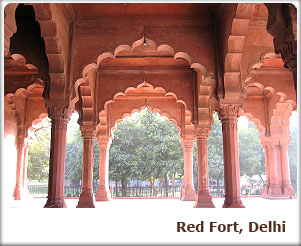 Day 19
Day 19
Mandawa – Delhi – Departure:
By Road 260Kms/05hrs
Breakfast will be at the hotel.
Proceed to Delhi. Reach and enjoy last minute shopping.
As per your INTERNATIONAL FLIGHT TIMINGS you’ll be transferred to the airport to take your flight back home with sweet memories of RAJASTHAN TOUR
...........................................................................TOUR ENDS...........................................................................
INCLUSIONS:
Delhi Arrival:
COMPANY REPRESENTATIVE will receive you on arrival at the DELHI AIRPORT and transfer to your hotel.
DELHI, the capital of kingdoms and empires is now a sprawling metropolis with a fascinating blend of the past and the present. It is a perfect introduction to the composite culture of an ancient land. A window to the kaleidoscope - that is India.
Overnight will be at Delhi.
 Day 02
Day 02 Delhi:
After breakfast proceed for a day sightseeing tour of the city.
The city is dotted with historic monuments that are the most popular tourist attractions in Delhi. Apart from the monuments, there are museums, markets, gardens and eating joints that you can visit on your tour of Delhi. Some of the important sightseeing places in Delhi are given below.
INDIA GATE: It is the war memorial dedicated to Indian soldiers, who died during World War I. The name of many soldiers who died during World War I is inscribed on its wall. Edward Lutyens, the man who planned and built New Delhi, designed India Gate. Almost every foreign tourist visits the monument. 'Amar Jawan Jyoti', the eternal flame is added later. The eternal flame runs on gas and is a tribute to soldiers who lost their lives in the service of the nation.
RED FORT: Located in Old Delhi, the Red Fort or Lal Quila is a popular tourist attraction in Delhi. The fort was built by the Mughal emperor Shah Jahan in 1648, when he moved his capital from Agra to Delhi. The construction of the Fort started in 1638 and it was completed 10 years later in 1648. Some of the important spots inside the Red Fort include royal baths or Shahi hamams, Shahi Burj, Moti Masjid or the Pearl Mosque, Diwan-e-Aam and Diwan-e-Khas.
JAMA MASJID: The largest mosque in India, the Jama Masjid was built by Shah Jahan 1656 AD. About 5,000 laborers and craftsmen worked for six years to complete the monument. The mosque can accommodate about 25,000 people. The mosque is located in the old Delhi. The domes are built in white marble. The prayer hall of the mosque has 260 pillars.
OLD FORT: Old Fort or Purana Quila as it is called is located near Pragati Maidan on the Mathura Road. You can club a visit to the Old Fort with your tour of Red Fort and Jama Masjid as the three monuments are located in Old Delhi and are not too far from one another. Humanyun’s started the construction of the fort in 1533 AD, but before the completion of the fort, Sher Shah Suri defeated him and captured Delhi. Sher Shah Suri completed the fort and named it -Shergah. He added many structures to the fort, of which Qila-I-Kuhna Mosque and Sher Mandal are worth mentioning. In 1555, Humanyun’s re-captured Delhi and converted Sher Mandal into a library.
HUMANYUN’S TOMB: Humanyun’s Tomb is mausoleum of the Mughal emperor Humanyun’s. Bega Begum also known as Haji Begum, wife of Humanyun’s constructed the mausoleum for her husband. The tomb was built between 1562 and 1572 AD. The tomb was designed by Mirak Mirza Ghiyuth.
QUTAB MINAR: The construction of the Qutab Minar was stated by Qutub-ud-din Aibak in 1199 AD but he died before completing it. His son-in-law and successor Iltutmish completed the construction of the building. Qutab Minar is located in Meharauli.
LOTUS TEMPLE: Also known as the Bahai Temple, the monument was opened to public only in 1986. Located near Nehru Place, the Lotus Temple is designed like a lotus flower. If you are looking for some moments of peace and tranquility in the crowded city, Lotus Temple is the ideal place to visit.
Apart from the above-mentioned sightseeing options, there are various other tourist attractions that you can visit on your tour of Delhi. Some other sightseeing places in Delhi include Lodi Gardens, National Museum, Jantar Mantar, Dilli Haat and the Garden of Five Senses.
Overnight will be at Delhi.
 Day 03
Day 03 Delhi – Mathura – Vrindavan - Agra:
BY Road 202Kms/05hrs
Breakfast will be at the hotel.
Drive to Agra visiting Mathura & Vrindavan enroute.
The divine land, the home of Lord Krishna that still pounding with the spiritual memoir of the Lord's vast charisma; It is believed that this is the place where about 5,000 years ago Lord Krishna was born in the prison of King Kansa.
Mathura an ancient holy city in India derives its eminence from being the birthplace of Lord Krishna. Situated at a distance of 145 kms from Delhi and 58 kms from Agra in the state of Utter Pradesh, the city is known for its many temples dedicated to the Lord Krishna located at Katra, Keshav Deo, the temples are visited by pilgrims from all over the world. The Temple Dwarkadish built by Seth Gokul Das of Gwalior in 1814 is arrayed with some ethereal pictures depicting the entire life of Krishna.
In 600 BC Mathura was the capital of Braj situated on the West Bank of river Yamuna. Today Mathura has become the sacred place of religious and epic interest and attracts pilgrims from the Hindu, Buddhist and Jaina religion. All round the year, a large number of festivals and fairs are held in Mathura and the bordering areas of Vrindavan, Gokul, Barsana and Goverdhan.
Reach Agra and check into the hotel.
AGRA: Two great Mughal monarchs, Akbar and Shah Jahan, transformed the little village of Agra into a befitting second capital of the Mughal Empire – giving it the name Dar-ul-Khilafat {seat of the Emperor}. Today a visitor to Agra is caught up in a world of contrasting edifices, of red sandstone and white marble, narrow galleys and quaint buggies, and that irresistible charm that this favorite city of the Mughals still retains. It is not surprising, that modern Agra still reflects its Mughal heritage most conspicuously. A walk down the narrow bustling streets of the city will introduce the visitor to the wafting aroma of Mughlai cuisine.
Overnight will be at Agra.
Day 04
Agra:
Enjoy breakfast at the hotel.
Proceed for day sightseeing of Agra.
 THE TAJ MAHAL – AN EMPEROR’S LAMENT: Agra is the city of the Taj Mahal. It is a sublime experience of the greatest love story ever told. Today India's most fascinating and beautiful masterpiece, this perfectly symmetrical edifice is set amidst landscaped gardens on the banks of the Yamuna River. The Taj was built by the Mughal Emperor Shahjahan as a memorial to his wife, Mumtaz Mahal. After her untimely death, Shah Jahan had her mortal remains buried in this mausoleum. And after his own demise he was placed to rest next to his beloved queen in the same mausoleum. Under the dome, below the ground level, in a dimly lit chamber, lie the mortal remains of Shahjahan and his beloved queen Mumtaz, reminding the world of their undying love. The Taj remains closed for visitors on Friday
THE TAJ MAHAL – AN EMPEROR’S LAMENT: Agra is the city of the Taj Mahal. It is a sublime experience of the greatest love story ever told. Today India's most fascinating and beautiful masterpiece, this perfectly symmetrical edifice is set amidst landscaped gardens on the banks of the Yamuna River. The Taj was built by the Mughal Emperor Shahjahan as a memorial to his wife, Mumtaz Mahal. After her untimely death, Shah Jahan had her mortal remains buried in this mausoleum. And after his own demise he was placed to rest next to his beloved queen in the same mausoleum. Under the dome, below the ground level, in a dimly lit chamber, lie the mortal remains of Shahjahan and his beloved queen Mumtaz, reminding the world of their undying love. The Taj remains closed for visitors on FridaySIKANDRA: Sikandra, 10 Kms North West of Agra, is the final resting place of Emperor Akbar. The Tomb of Akbar shows an interesting fusion of Hindu and Mughal architecture reflecting the spirit of the Mughal Emperor Akbar. Akbar began the construction of his own garden mausoleum during his lifetime, a red sandstone structure in a char-Bagh meaning 4-square formal garden.
AGRA FORT – ARCHITECTURAL WONDER IN STONE: Within a radius of 3 kilometers, on the banks of the river Yamuna raises the crescent like Agra Fort. Designed and built by Akbar in 1565 A.D., the fort is surrounded by a 70 feet high wall. It houses the beautiful Pearl Mosque and numerous palaces including the Jahangir Mahal, Diwan-i-Khas, Diwan-i-Am and Moti Masjid. Later it was used by his son Jahangir also as the seat of power. Shahjahan modeled his creation, the Red Fort at Delhi on this fort. The Agra fort happens to be on the same bank of the river Yamuna as the Taj Mahal which is visible in all its beauty from one side of the fort. So very ironically, Shahjahan, a prisoner of his son Aurangzeb in his old age was put in a cell from where he could gaze at the Taj Mahal at a distance, from his cell in the Agra Fort.
The fort has four gates and is enclosed by a double barricaded wall of red sand stone. Many buildings were constructed within the fort of which very few remain till date. One of the most significant ones is the multi storied Jahangir Mahal built by Akbar for his wife Jodha Bai.
The Mahal is reached through an impressive gateway and its inner courtyard consists of beautiful halls, profuse carvings on stone, exquisitely carved heavy brackets, piers and cross beams.
ITMAD – UL – DAULAH’A TOMB: This tomb was erected by Nur Jahan in sweet memory of her father Ghiasud-Din-Beg between 1622 - 1628 A.D. This white marble structure of the pre-Taj era though smaller is often considered equal if not better to the great one itself.
Overnight will be at Agra.
Day 05
Agra – Fatehpur Sikri – Jaipur:
BY Road 232Kms/05hrs
Breakfast will be at hotel.
Drive to Jaipur visiting Fatehpur Sikri enroute.
FATEHPUR SIKRI – THE CITY OF VICTORY: 37 Kms from the city of Agra, stands Fatehpur Sikri, Akbar’s capital. Full credit goes to the Archeological Survey of India for this perfectly preserved example of a Mughal city at the height of the empire’s splendor. It is an attraction no visitor to Agra should miss. This sprawling structure is made of red sandstone and combines both Hindu and Mughal architecture. This walled city contains the mausoleum of the Sufi fakir, Saleem Chisti who is said to have granted Akbar and his Hindu queen Jodhabai their wish for a son. The main entrance to Fatehpur Sikri is through the 175 feet Buland Darwaza, the highest gateway in the world. It was built by Akbar to commemorate his victory over Khandesh in Gujarat.
The Panch Mahal is a five-storeyed tower, the highest point in Fatehpur Sikri. This extremely airy tower is supposed to have been used by one of the emperor's many queens.
After lunch continue drive to beautiful Pink City – Jaipur. Reach and check in at hotel.
Jaipur is the capital of the state of Rajasthan a romantic realm of resplendent palaces, mighty fortresses and regal Maharajahs that lies in the western deserts and is an utterly unique part of India. Proudly belonging to the KSHATRIYA warrior caste and fiercely independent, the Rajput princes made fearsome foes. However, many of them realized that to maintain their wealth and authority locally, it was expedient to proclaim allegiance to the central power. Thus, many enjoyed a privileged position under the Mughal emperors and also the British Raj that followed.
The bustling Rajasthan capital of Jaipur takes its name from its venerated founder Jai Singh II, who was given the title Sawai Maharaja by the Mughal. Literally translated this would mean ’one and a quarter’, suggesting that the Mughal thought this emperor to be more valuable than just ‘one’. Jaipur is known as the ’Pink City’ on account of the distinctive colour of its buildings. This did not, however, form part of the original plan, but dates back to 1856, when the city was given a wash of pink in honor of a State Visit from Prince Albert.
This evening, visit the Birla Temple to learn more about the fascinating religious life of Jaipur. The marble structure, built as recently as 1985, houses ornate statues including one of Lakshmi (goddess of Wealth and Beauty) and Narayan dressed in gaudy robes, representing a Hindu vision of heavenly luxury. Carvings in the temple and on pillars supporting the covered walkways include images of the Hindu pantheon, as well as Jesus, the Blessed Virgin Mary and St Francis of Assisi. Your visit will coincide with the AARTI Ceremony, which involves oil lamps being lit and waved, in order to awake and invoke the deity.
Enjoy the experience and spend night at Jaipur.
Day 06
Jaipur:
After breakfast drive to Amber Palace. Enjoy Elephant Back ascent to the Fort.
AMER PALACE & FORT: Amer Fort and Palace was originally built by Raja Man Singh and subsequently developed by Sawai Jai Singh. The major attractions are Sheela Devi Temple, Sheesh Mahal (Hall of mirrors), Jai Garh Fort a few kilometers from the city centre was built for the defence of the town and has one of the world’s biggest cannons on wheels and a rich collection of arms and weapons.
Continue city sightseeing.
 HAWA MAHAL (PALACE OF WINDS): Hawa Mahal is the most strikingly designed monument in Jaipur. Built by the Poet-King Sawai Pratap Singh in 1799, the Hawa Mahal is centrally located and is multiniched five storey high back view of the compled. It was conceived to provide an adequate vantage position behind delicate stone-carved jali, screens for the palace women to watch the royal processions passing through the Bazar below without being seen by outsiders. The Top of the palace affords a beautiful view of the city. A small archaeological museum is yet another attraction in the palace.
HAWA MAHAL (PALACE OF WINDS): Hawa Mahal is the most strikingly designed monument in Jaipur. Built by the Poet-King Sawai Pratap Singh in 1799, the Hawa Mahal is centrally located and is multiniched five storey high back view of the compled. It was conceived to provide an adequate vantage position behind delicate stone-carved jali, screens for the palace women to watch the royal processions passing through the Bazar below without being seen by outsiders. The Top of the palace affords a beautiful view of the city. A small archaeological museum is yet another attraction in the palace.JAL MAHAL: The Jal Mahal Palace, Jaipur is noted for its intricate architecture. The Palace was developed as a pleasure spot. It was used for the royal duck shooting parties. On the road to Amber at a distance of 6.5 Kms from Jaipur are the cenotaphs of the royal family. A causeway leads to Jal Mahal Palace situated in the middle of Man Sagar Lake, opposite the cenotaphs. The first four floors of this building is under water, only the top floor remains outside. One can have a wonderful view of the lake and the palace from Nahar Garh Fort Built in 1799, the palace is now abandoned, but reasonably well preserved. In the monsoons, it looks particularly startling with its red sandstone set against the water hyacinth filled lake.
THE CITY PALACE: The city Palace is a historic landmark. The Carved arches are supported by grey-white marble columns studded with floral motifs in gold and colored stones. Two elephants carved in marble, guard the entrance, where retainers whose families have served generations of the rulers are at hand, to serve as guides.
JANTAR MANTAR Jantar Mantar is one of Sawai Jai Singh’s five remarkable observatories. Constructed with stone and marble its compled instruments, whose setting and shapes are precisely and scientifically designed, represent the high-points of medieval Indian Astronomy. The two Ram Yantras used for gauging altitudes are unique in their isolation. This is the largest of five observatories founded by Sawai Jai Singh-II in various parts of the country.
This evening is free for you to relax shop or explore independently. Shopping is superb in Jaipur, particularly for gold and silver jewellery, pottery, tie-dye materials, silk, saris, wooden handicrafts and carpets.
Overnight will be at Jaipur.
Day 07
Jaipur – Ranthambhore:
By Road 170Kms/05hrs
Breakfast will be at the hotel.
Drive to Ranthambhore. Reach and check into the hotel.
Ranthambore National Park is in Sawai Madhopur District of Rajasthan state. Located at the junction of the Aravalli and Vindhya hill range, this is one of the finest places to view animals, especially as they are used to being stared at here. The park covers an area of Approximately 400 sq Km and if combined it with the area of sawai man Singh sanctuary area, it is around 500 Sq km.
Ranthambore national park was declared a wildlife sanctuary in 1957 and in 1974 it gained the protection of "Project Tiger". It got its status of a National Park in 1981. Ranthambore National Park is dotted with structures that remind you of bygone eras. There are many water bodies located all over the park, which provide perfect relief during the extremely hot summer months for the forest inhabitants. A huge fort, after which the park is named, towers over the park atop a hill. There are many ruins of bygone eras scattered all over the jungle, which give it a unique, wonderful and mixed flavor of nature, history and wildlife. Tigers at Ranthambore National park have been known to even hunt in full view of human visitors. These tigers are famous for being seen in the daytime too, due to their lack of fear of human presence in vehicles. This lack of fear of humans is excellent for tourists, as they get to see the tigers often.
This National park is a wildlife enthusiast and photographer's dream. It offers excellent accommodation and internal transportation facilities. The park remains open every year from October to May. Famous for the exciting and frequent tiger sightings captured dramatically in several books, this park is today affected by ecological pressures and poaching.
In Nutshell, Ranthambore National park is a wildlife enthusiast and photographer's dream.
Timings for entry into, and exit from, the park vary according to the season. In winters, due to the shorter duration of daylight hours, the morning entry time is later and evening exit time is earlier.
Overnight will be at Ranthambore.
 Day 08
Day 08 Ranthambhore:
Wake up early morning and leave for your safari into the National Park. Track the tigers and other wildlife through the morning. Return to the resort / lodge by 1000 in the morning and have breakfast.
Freshen up and either spends time at the pool or visit the town. You could also go for a nice visit to the temple on top of the fort.
In the afternoon have lunch and then leave again for you afternoon safari. The safari will be till evening 1700 – 1800 hr and then return to the resort / lodge.
Dinner will be at the resort and retire early for the night.
Overnight will be at Ranthambhore.
Day 09
Ranthambhore – Bundi:
By Road 130Kms/03hrs
Breakfast will be at the hotel.
Drive to Bundi. Reach and check into the hotel.
The Bundi district of Rajasthan attracts tourist from all over the world. The destination provides tourist spots for both the foreign and domestic visitors. The place offers a unique culture with baoris, palaces & forts, lakes and the beautiful natural surroundings. Bundi is known for attractive step wells and tanks. These are about 50 in number and mark the town's streets and bylanes. Interesting monuments including impressive medieval forts, palaces, 'havelis', temples and 'chhatris' with elegantly carved pillars, along with a picturesque lake in the heart of the town, add to its appeal.
Relax and then proceed for the sightseeing.
Taragarh or the Star Fort: The fort was built in 1354 A.D., and is one of the most impressive forts of Rajasthan. Located on a thickly wooded hill is a marvelous white fort with a huge reservoir, which once supplied water to the palace.
The Palace: This magnificent edifice showcases the Rajput architecture. The palace houses some of the superb Bundi murals.
Chhattar Mahal or Palace or Towers: A steep, paved carafe-way is the only way to reach the monument. Of special interest in the palace is the Hazari Pol or Gate of the thousand, the Naubat Khana, the Hathi Pol with its old water clock and the Diwann-e- Aam.
Ratan Daulat: It is a very interesting structure built by Rao Raja Ratan Singh, forming a stable for nine horses and a Hatia Pol. Prior permission required to visit this place.
Chitrashala: This is an interesting pavilion and a gallery of miniature murals adorns the palace. Elaborate colorful paintings on the walls depict scenes from the 'Ragmala' and 'Raaslila'-the Radha-Krishna story.
Nawal Sagar: Visible from the fort is the square artificial lake of Nawal Sagar, broken up by islets. A temple dedicated to Varuna, the Aryan god of water, stands half submerged in the center of the lake. The reflection of the entire city and its palaces can be seen in the lake -making it a unique attraction of Bundi.
Overnight will be at Bundi.
Day 10
Bundi – Chittaurgarh:
By Road 180Kms/05hrs
Breakfast will be at the hotel.
Drive to Chittaurgarh. Reach and check into the hotel.
Chittaurgarh showcases the royalty and glory of Rajasthan in the form of its various magnificent forts and monuments. It is a ruined citadel where the royal past lives in the imposing forts, graceful palaces and spectacular chhatris. The entire city echoes with the tales of love and gallantry unique to the Rajput tradition. This fortified settlement has been ravaged thrice and each time the outcome was ‘Jauhar’-when women and children immolated themselves on a huge funeral pyre while men donned in saffron robes of martyrdom rode out of the fort towards a certain death.
Relax and then proceed for the sightseeing.
 The Fort: The indomitable pride of Chittaur, the fort is a massive structure with many gateways built by the later Maurya rulers in 7th century A.D. Perched on a height of 180 m. high hill, it sprawls over 700 acres. The tablets and chattris within are impressive reminders of the Rajput heroism. The main gates are Padal Pol, Bhairon Pol Hanuman pol and Ram Pol. The fort has many magnificent monuments-all fine examples of the Rajput architecture. The ancient ruins of the fort are worth spending few moments in solitude.
The Fort: The indomitable pride of Chittaur, the fort is a massive structure with many gateways built by the later Maurya rulers in 7th century A.D. Perched on a height of 180 m. high hill, it sprawls over 700 acres. The tablets and chattris within are impressive reminders of the Rajput heroism. The main gates are Padal Pol, Bhairon Pol Hanuman pol and Ram Pol. The fort has many magnificent monuments-all fine examples of the Rajput architecture. The ancient ruins of the fort are worth spending few moments in solitude.Vijay Stambh (Victory Tower): The imposing 37 meter high structure with nine storeys, covered with exquisite sculptures of Hindu deities and depicting episodes from the two great epics - Ramayana and Mahabharata. It was built in 1440 A.D. by Maharana Kumbha, a powerful ruler of Mewar, to commemorate his victory over the Muslim rulers of Malwa and Gujarat.
Kirti Stambh (Tower of Fame): The 22 meter high tower by a wealthy JAIN merchant in the 12th century A.D. The tower is dedicated to Adinathji, The first of the Jain Tirthankaras and is decorated with figures of the Jain pantheon.
Rana Kumbha’s Palace: The ruined edifice of great historical and architectural interest, being the most massive monument in the fort of Chittaur. The palace is believed to have underground cellars where Ranio Padmini and other women committed Jauhar.
Padmini’s Palace: Built beside a pool, the palace is a magnificent one. It was here that Rana Ratan Singh showed a glimpse of queen Padmini to Alauddin Khilji. Rani Padmini stood in a ‘Zanana Mahal’- a pavilion in the centre and her reflection was visible to Alauddin Khilji in a mirror placed in the main hall. After having a glimpse of the legendary beauty, Alauddin went to extend to ravaging Chittaur in order to possess her.
Government Museum: The magnificent Fateh Prakash Mahal, presently a fine Museum with an exquisite example of sculptures from temples and buildings in the fort is worth a visit.
Jaimal and Patta Palaces: The ruins of palaces of Rathore Jaimal and Sisodia Patta are witness to the gallantry of these great warriors.
Overnight will be at Bijaipur.
 Day 11
Day 11 Bijaipur – Udaipur:
By Road 180Kms/05 hrs
Breakfast will be at the hotel.
Drive to Udaipur. Reach and check into the hotel.
The city of Dawn, Udaipur is a lovely land around the azure lake, hemmed in by the lush hills of the ARAVALLIS. A vision in white drenched in romance and beauty, Udaipur is a fascinating blend of sights, sound and experiences and inspiration for the imagination of poets, painters and writers.
Its kaleidoscope of fairy-tale palaces, lakes, temples, gardens and narrow lanes strewn with stalls, carry the flavor of a heroic past, epitomizing valor and chivalry. Their reflection in the placid waters of the LAKE PICHOLA is an enticing sight. Udaipur is the jewel of MEWAR -a kingdom ruled by the Sisodia dynasty for 1200 Years.
Overnight will be at Udaipur.
Day 12
Udaipur:
Breakfast will be at hotel.
Proceed for sightseeing tour of Udaipur, stopping first at City Palace.
CITY PALACE: Udaipur’s fascinating City Palace is the largest royal complex in Rajasthan. Standing on a rocky promontory the palace has balconies, towers and cupolas and presents a wonderful view of the lake and the city. The complex has eleven constituent Mahals (palaces), constructed by successive maharanas during the three hundred years that followed the foundation of Udaipur in 1559. Added to this, Crystal Gallery and Durbar Hall within the complex is spectacular. Explore them for their mosaics, miniatures, mirror work and motifs.
Here you will marvel at rooms with mirrored walls and ivory doors, colored glass windows and inlaid marble balconies and the Peacock Courtyard.
SAHELION KI BARI: The "garden of the maids of honour", Sahelion-ki-Bari was designed and laid out early in the eighteenth century as a retreat for ladies of the royal household to spend their time in leisure. The lotus pool, fountains, lawns, flowerbeds, and marble pavilions all combine to make it a captivating place.
BAGORE KI HAVELI: Situated on the picturesque bank of Pichola Lake, This Haveli was built by Shri Amarchand Badwa, who was the Prime Minister of Mewar-the rulers of Mewar Pratap Singh, Maharana Ari Singh, and Maharana Hamir Singh during the period 1751 to 1778. This palatial building reportedly has 138 rooms, balconies, terraces, courtyards and corridors. The glass and mirror inlay within the Haveli is Unique and procured in its original form. The two peacocks made with small pieces of colored glasses are unique reflection of the finest craftsmanship of glass work. What was once upon a time a living centre of nobility of Udaipur lay in darkness and ruin for nearly half a century till when it was handed over to the West Zone Cultural Centre (WZCC) in 1986.
 JAGDISH TEMPLE: Built in 1651 A.D. by Maharana Jagat Singh, this Indo-Aryan temple is dedicated to Lord Jagannath, a manifestation of Vishnu. The largest and the most beautiful temple of Udaipur, it is always seething with constant activity and noted for its beautiful sculpted images and towering Shikhara.
JAGDISH TEMPLE: Built in 1651 A.D. by Maharana Jagat Singh, this Indo-Aryan temple is dedicated to Lord Jagannath, a manifestation of Vishnu. The largest and the most beautiful temple of Udaipur, it is always seething with constant activity and noted for its beautiful sculpted images and towering Shikhara.FATEH SAGAR: West of Sahelion-ki-Bari is Fateh Sagar, a lake built by Maharana Fateh Singh. It is bordered by sharp hills and a canal built at the beginning of the twentieth century connects it to the Lake Pichola. In the middle of the lake is Nehru Park, a popular garden island with a boat-shaped cafe.
BHARATIYA LOK KALA MANDIR: Bharatiya Lok Kala Mandir is home to an attractive collection of folk dresses, puppets, ornaments, dolls, masks, folk musical instruments, folk deities and paintings. The museum is the best place for those interested in puppetry. Short amusing puppet shows are staged throughout the day. In addition, the museum runs short courses in puppet making and theatre.
Proceed for Evening Motor launch cruise on the placid waters of Lake Pichola. From the boat you will be able to view the city of Udaipur as it rises majestically above the lake in the middle of the Rajasthan desert. Also visit the Jag Mandir Palace - the other island palace in the middle of the lake. Spend some time at the Jag Mandir Palace.
JAG MANDIR: Jag Mandir, another island palace in the Lake Pichola was built by Karan Singh in 1615. It derives its name from Jagat Singh who added to the initial structure. It was never used for the purpose for it was built. This palace was used to provide shelter to the Mughal prince Khurum (later Emperor Shah Jahan) who rebelled against his emperor father Jahangir, in the 1620s. Jahangir was succeeded by Shah Jahan who was still in Udaipur at the time of his father's death. During the 1857 Mutiny this island palace once again served as a safe haven for European women and children.
Overnight will be at Udaipur.
Day 13
Udaipur – Narlai:
By Road 140kms/02hrs
Breakfast will be at the hotel.
Proceed to Narlai. Reach and check into the hotel.
Situated in Narlai Village in Pali is the Rawla Narlai. The Rawla Narlai, Pali belongs to the royal family of Jodhpur. One of the ancient 17th century forts it was renovated by Maharaja Swaroop Singhji into a famous heritage hotel in Pali. The refurbished Rawla Narlai in Pali recreates the medieval magic of yesteryears which allures tourists from all over.
Enjoy evening in Narlai.
Overnight will be at the hotel.
Day 14
Narlai – Rohet:
By Road 80kms/01hrs
Breakfast will be at the hotel.
Proceed to Rohet. Reach and check into the hotel.
ROHET is the fortified desert home of the descendants of the 16th century Rathore of the Champawat clan, Thakur Dalpat Singh I. The "Jagir" (Fiefdom) of Rohet was bestowed upon him in 1622 A.D. by the Maharaja of Jodhpur, as a mark of appreciation for his bravery in battle. Generations of valiant noble-men have built this heritage home where, notwithstanding the inroads of modernity, aristocratic values are respected. The visitor of today experiences the famed warmth of courteous Rajput hospitality.
Brilliantly plumed peacocks strut about, perching themselves under finely carved stone archways and the wind whispers through the neem tree groves and bougainvilleas.
Rohet Garh is a recognized Heritage Hotel. Rare among hotels it has remained a family home, where the members of the erstwhile ruling family welcome you personally as their honored guest. Its elegantly appointed rooms have their own individual character and furnishings. Rooms are air-conditioned and have attached bathrooms and modern facilities. The drawing room has ornately carved wooden ceiling, traditional lamps and old photographs. You are invited to relax in spacious verandah lounges decorated with historic trophies and artifacts.
There is a beautifully designed swimming pool with four charming pavilions at each corner where musicians perform in the evenings as dinner is served by the poolside. Often, folk dancers enliven the evenings with their vibrant hues and vigorous rhythms.
Overnight will be at the hotel.
 Day 15
Day 15 Rohet – Jaisalmer:
By Road 235kms/6.5hrs
Breakfast will be at the hotel.
Drive to Jaisalmer. Reach and check into the hotel.
Rising from the heart of the Thar Desert like a golden mirage is the city of Jaisalmer. A commanding fort etched in yellow sandstone stands, with its awesome splendor, dominating the amber-hued city.
The city has an interesting legend associated with it, according to which, Lord Krishna-the head of the Yadav Clan, foretold Arjuna that a remote descendent of the Yadav Clan would build his kingdom atop the Trikuta Hill. His prophecy was fulfilled in 1156 AD when Rawal Jaisal, a descendent of the Yadav Clan and a Bhatti Rajput, abandoned his fort at Lodurva and founded a new capital -Jaisalmer, perched on the Trikuta Hill.
Overnight will be at Jaisalmer.
Day 16
Jaisalmer:
After breakfast proceed for the sightseeing.
JAISALMER FORT: The 12th century Jaisalmer Fort is one of the most formidable forts in Rajasthan, India. Perched on Trikuta hill, Jaisalmer Fort is a 250 ft tall and massive fort surrounded by a 30 ft high sandstone wall with 99 bastions, offering a spectacular sight to visitors. The Fort also houses a Jain Temple.
JAISALMER HAVELIS: Once the residence of wealthy merchants, the havelis (mansions) of Jaisalmer are famous for their artistic designs and decorations. Their exclusive cutwork, yellow and red stone treatment, and the bracket-shaped decoration of peacocks, never fail to mesmerize the visitors. The Patwon-Ki-Haveli, Salim-Singh-Ki-Haveli and Nathmal ji-Ki-Haveli are major tourist attractions in Jaisalmer.
NATHMAL KI HAVELI: Two architect brothers built it in the 19th century. Interestingly, while one concentrated on the right, the other concentrated on the left and the result is a symphony epitomizing the side by side symmetry during construction. Paintings in miniature style monopolize the walls in the interior. Mighty tuskers carved out of yellow sandstone stand guard to the Haveli.
SALIM SINGH KI HAVELI: This Haveli was built about 300 years ago and a part of it is still occupied. Salim Singh was the prime minister when Jaisalmer was the capital of the princely state and his mansion has a beautifully arched roof with superb carved brackets in the form of Peacocks. The mansion is just below the hill and it is said that once it had two additional wooden storeys in an attempt to make it as high as the maharaja's palace, but the maharaja had the upper storey torn down.
 PATWON JI KI HAVELI: This is one of the largest and most elaborate Haveli in Jaisalmer and stands in a narrow lane. It is five storeys high and is extensively carved. It is divided into six apartments, two owned by archaeological Survey of India, two by families who operate craft-shops and two private homes. There are remnants of paintings on some of the inside walls as well as some mirror work.
PATWON JI KI HAVELI: This is one of the largest and most elaborate Haveli in Jaisalmer and stands in a narrow lane. It is five storeys high and is extensively carved. It is divided into six apartments, two owned by archaeological Survey of India, two by families who operate craft-shops and two private homes. There are remnants of paintings on some of the inside walls as well as some mirror work.GADSISAR SAGAR LAKE: A famous picnic spot in the sandy city, Gadsisar Sagar Lake is among the most beautiful tourist attractions in Jaisalmer. It attracts hundreds of migratory birds during the winter season. Bara Bagh: Located on the bank of Gadsisar Sagar Lake, Bara Bagh is an oasis in the desert. The lush green garden provides much-needed relief to the local people.
TAZIA TOWER: The pagoda like Tazia Tower rises from the Badal Mahal (Palace of Clouds). The beautiful five-tiered tower is known for its beautifully carved balconies on each storey.
JAIN TEMPLES: These fine Jain temples were built in the 12th to 15th century, within the Jaisalmer Fort. They are beautifully carved and dedicated to Rikhabdevji and Sambhavnathji. The Gyan Bhandar, a library containing some extremely old manuscripts, is within the temple complex.
In the late afternoon, proceed to the SAND DUNES for visiting the typical Rajasthani Desert Village. View the sunset from the dunes, as the sky is set on fire. Return to the village for dinner amidst Rajasthani musicians playing haunting tunes.
Overnight will be at Jaisalmer.
Day 17
Jaisalmer – Gajner:
By Road 330Kms/06hrs
After breakfast proceed to Gajner. Reach and check into the hotel.
Gajner Palace is a Grand Heritage Palace of the HRH Group of Hotels. Spread over 6000 acres, the palace is a 30-minute drive from Bikaner. Gajner Palace was built on the banks of Gajner Lake by Sir Ganga Singhji, one of the greatest Maharajas of Bikaner, in the early decades of the twentieth century.
Gajner Palace was used as a hunting resort by the former Maharajas and visiting British dignitaries during the days of the Raj. During the reign of Maharaja Ganga Singh, this palace was used for grand shoots and lavish entertainment. Christmas season was often celebrated with prearranged duck and Imperial Sand Grouse shoots. Royalty, Viceroys and other dignitaries were usually invited on these grand occasions.
The red sandstone palace is distinguished for its architectural grandeur and luxuriously appointed suites and rooms. The greenery at Gajner Palace, lawns and the chirping of birds and peacocks make it a truly memorable destination for leisure and corporate travellers.
Relax and then proceed for the sightseeing.
Overnight will be at Gajner.
 Day 18
Day 18 Gajner – Bikaner - Mandawa:
By Road 140Kms/04hrs
After breakfast proceed to Mandawa visiting Bikaner enroute.
Bikaner is a beautiful city in the northwestern part of Rajasthan and is a major tourist attraction of the state. Junagarh Fort, camel breeding farm and camel festival are the major tourist attractions of Bikaner. Besides, there are various other tourist attractions of Bikaner like Lalgarh Palace, Deshnoke temple, Karni Mata etc. that you must visit on your Bikaner Travel. The Rajputana Getaway offers to give you online information on other tourist attractions in Bikaner in Rajasthan, India.
Reach Mandawa and check into the hotel.
Mandawa is one of the beautiful historical towns which attract tourists from all over. A few kilometers from Jaipur, Mandawa is one of the sleepy hamlets of Rajasthan that recalls the glory and grandeur of yesteryears.
From grand Forts, Havelis and palatial mansions, Mandawa is truly one of the ideal destinations for the history lovers. From paved archways to mirror works, paintings and murals and exquisitely designed architectural marvels, Mandawa is considered to be an open air art gallery.
The Tourist Attractions in Mandawa are all about these beautiful forts and Havelis. One of the important tourist attractions of Mandawa is the beautiful Mandawa Fort. Constructed in the year 1797, it was built by the Shekhawati ruler, Nawal Singh. Mandawa Fort is truly a class apart in elegance and grandeur. Beautifully painted murals and paintings, arched doorways, pictures depicting mythological characters recreate the quaint medieval ambience. Around this Mandawa Fort the township of Mandawa slowly developed. Today the fort is not only a mere tourist attraction in Mandawa but it has been renovated into one of the heritage hotels of Rajasthan.
The Hanuman Prasad Goenka Haveli is one of the interesting tourist attractions in Mandawa. In this Haveli you can get to see beautiful paintings which depict Indian mythological characters like Indra Dev and Lord Shiva. The Goenka Double Haveli has a beautiful portico which is tastefully decorated with paintings of elephants and horses. The paintings of Murmuria Haveli are also quite noteworthy which depicts political leaders like Jawaharlal Nehru and a train at a level crossing. The Mohan Lal Saraf Haveli is in a good condition and is adorned with royal portraits.
Overnight will be at Mandawa.
 Day 19
Day 19 Mandawa – Delhi – Departure:
By Road 260Kms/05hrs
Breakfast will be at the hotel.
Proceed to Delhi. Reach and enjoy last minute shopping.
As per your INTERNATIONAL FLIGHT TIMINGS you’ll be transferred to the airport to take your flight back home with sweet memories of RAJASTHAN TOUR
...........................................................................TOUR ENDS...........................................................................
INCLUSIONS:
- ACCOMODATION AT SUGGESTED HOTELS,
- DAILY BUFFET BREAKFASTS,
- AC VEHICLE WITH THE DRIVER FOR ALL TRANSFERS & SIGHTSEEING AS PER THE ITINERARY,
- MEET AND ASSIST AT THE AIRPORT/STATION ON ARRIVAL/DEPARTURE,
- ENGLISH SPEAKING LOCAL GUIDES AT PPLICABLE PLACES
- RICKSHAW RIDE IN DELHI,
- HORSE CART RIDE TO TAJ MAHAL IN AGRA,
- FATEHPUR SIKRI EXCURSION,
- ELEPHANT RIDE AT AMER FORT, JAIPUR,
- JEEP SAFARIS IN RANTHAMBHORE,
- ALL MEALS IN RANTHAMBHORE,
- NATIONAL PARK ENTRANCE FEES,
- BOAT RIDE AT LAKE PICHOLA IN UDAIPUR,
- SAND DUNES CAMEL RIDE & DINNER IN JAISALMER,
- TOLL TAXES, DRIVER ALLOWANCE, PARKING, AND
- ALL APPLICABLE TAXES AND SERVICE CHARGES.
- LUNCHES & DINNERS,
- MONUMENT ENTRANCES,
- CAMERA CHARGES AT THE MONUMENTS,
- PORTER CHARGES,
- TIPS &
- PERSONAL EXPENSES.

